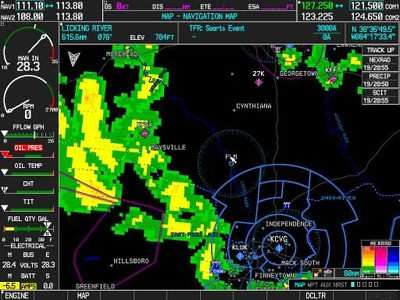Contract Estimated To Be Worth $20B Over Next Two Decades
 If they pull this
off... does that mean we'll be able to pick up Oprah in the
cockpit? Raytheon has tapped XM Satellite Holdings, Inc. to join
its bid for a federal contract that could change the way people
fly, by overhauling the nation's antiquated air traffic control
system.
If they pull this
off... does that mean we'll be able to pick up Oprah in the
cockpit? Raytheon has tapped XM Satellite Holdings, Inc. to join
its bid for a federal contract that could change the way people
fly, by overhauling the nation's antiquated air traffic control
system.
The Federal Aviation Administration is expected to award the
contract as early as next week. It is estimated to be worth more
than $2 billion over the next 20 years.
"This is a transformation of the air traffic control system,"
said FAA spokesman Paul Takemoto. "We've made quantitative leaps
over the years, from flags to bonfires to radars and now to
satellites."
The FAA figures it will spend around $15 billion to $22 billion
by 2025 on the new satellite technology -- automatic dependent
surveillance-broadcast (ADS-B) -- as well as new information
management systems and data communications, according to the Boston
Globe.
The agency is also planning to shell out another $14 billion to
$20 billion on new avionics compatible with the new satellite
technology.
"Even in today's environment, these are large contracts," said
Jon B. Kutler, founder and chief executive of Admiralty Partners, a
Los Angeles private equity firm specializing in aerospace and
defense. "It's an attempt to bring the air traffic control system
into the 21st century. Anybody who's flown this summer knows that
the air traffic control system in the United States is just behind
in capability."
It's worth noting Raytheon built much of the original equipment.
Other companies competing for the contract include Lockheed Martin
and ITT Corp; all three will employ satellite technology to allow
aircraft to fly closer together, thus reducing delays... although
they can't really say by how much.

The FAA says the satellite technology will permit narrower
separation... although it's not ready to say by how much,
either.
"This means that air traffic control will be able to move planes
through the system much faster than they can today," said Charles
E. Keegan, director of future air navigation systems for Raytheon's
Network Centric Systems division. "It's a real game-changer."
 Raytheon's partnership
with XM may give it a leg up in the bidding race. Its bid includes
XMWX technology that allows pilots to track accurate weather data
in the cockpit on moving displays -- enabling airlines to catch up
to general aviation, where the technology has been in limited use
for the past three years.
Raytheon's partnership
with XM may give it a leg up in the bidding race. Its bid includes
XMWX technology that allows pilots to track accurate weather data
in the cockpit on moving displays -- enabling airlines to catch up
to general aviation, where the technology has been in limited use
for the past three years.
"In many cases, the pilots -- or their passengers -- could be
listening to XM radio while they're using our weather
systems," said XM's Roderick MacKenzie. "A single receiver can
let the pilot keep tracking the weather and keep the passengers
entertained."
Raytheon says its system also works on a single frequency, and
it is compatible with systems currently being developed in Asia and
Europe. The other competitors are proposing a dual-frequency
system.
 ANN's Daily Aero-Linx (05.02.24)
ANN's Daily Aero-Linx (05.02.24) ANN's Daily Aero-Term (05.02.24): Touchdown Zone Lighting
ANN's Daily Aero-Term (05.02.24): Touchdown Zone Lighting Aero-News: Quote of the Day (05.02.24)
Aero-News: Quote of the Day (05.02.24) ANN FAQ: Contributing To Aero-TV
ANN FAQ: Contributing To Aero-TV NTSB Final Report: Cirrus Design Corp SR20
NTSB Final Report: Cirrus Design Corp SR20




